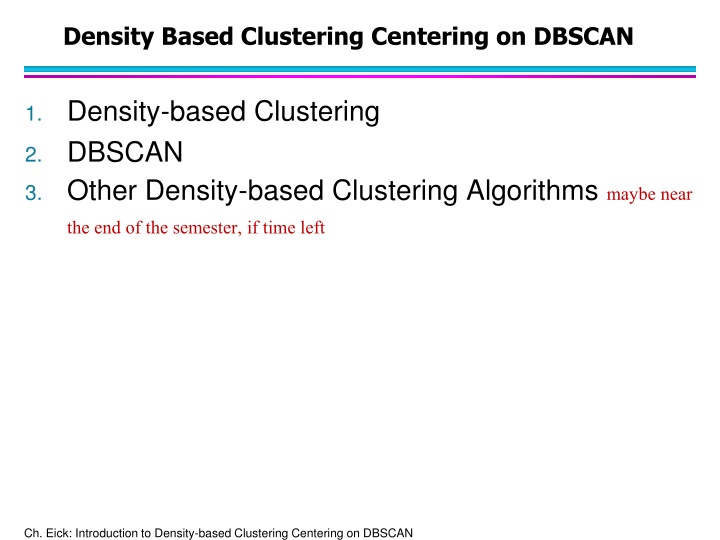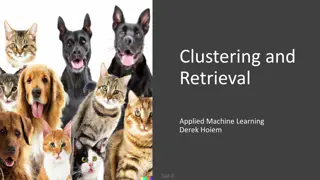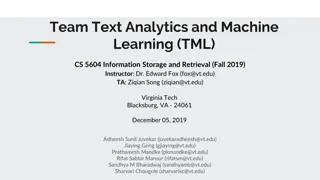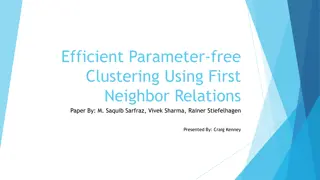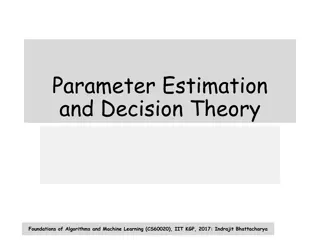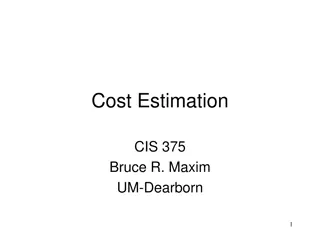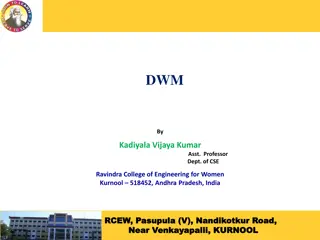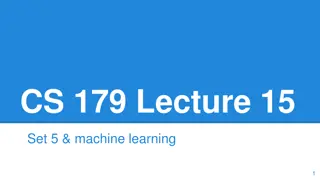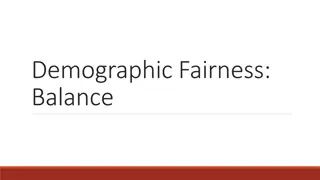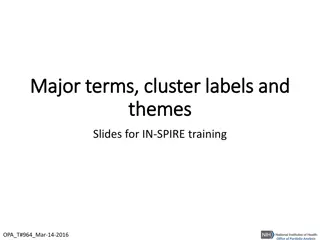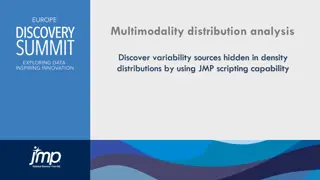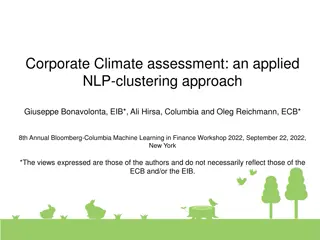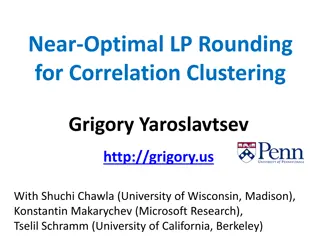Density-based Clustering: DBSCAN and Density Estimation
Density-based clustering algorithms like DBSCAN utilize density-estimation techniques to identify clusters based on data density. Density estimation involves constructing estimates of underlying probability density functions using various approaches such as non-parametric methods like Kernel density estimation.
Download Presentation

Please find below an Image/Link to download the presentation.
The content on the website is provided AS IS for your information and personal use only. It may not be sold, licensed, or shared on other websites without obtaining consent from the author.If you encounter any issues during the download, it is possible that the publisher has removed the file from their server.
You are allowed to download the files provided on this website for personal or commercial use, subject to the condition that they are used lawfully. All files are the property of their respective owners.
The content on the website is provided AS IS for your information and personal use only. It may not be sold, licensed, or shared on other websites without obtaining consent from the author.
E N D
Presentation Transcript
Density Based Clustering Centering on DBSCAN 1. Density-based Clustering 2. DBSCAN 3. Other Density-based Clustering Algorithms maybe near the end of the semester, if time left Ch. Eick: Introduction to Density-based Clustering Centering on DBSCAN
Density-based Clustering Density-based Clustering algorithms use density-estimation techniques: to obtain density functions over the space of the attributes; then clusters are identified as areas whose density is above a certain threshold (DENCLUE s Approach) to create a proximity graph which connects objects whose density is above a certain threshold in the neighborhood of an object; then clustering algorithms identify contiguous, connected subsets in the graph which are dense (DBSCAN s Approach). DBSCAN employs a na ve density estimation approach to estimate the density of dataset points. Ch. Eick: Introduction to Density-based Clustering Centering on DBSCAN
Density Estimation In probability and statistics, density estimation is the construction of an estimate, based on observed data, of an unobservable underlying probability density function. The unobservable density function is thought of as the density according to which a large population is distributed; the data are usually thought of as a random sample from that population (Wikipedia) Different Density Estimation Approaches: Na ve Approaches which estimate density by counting the number of objects in grids or other shapes. Parametric approaches which employ Gaussian or other models as density functions. Non-parametric approach which use the points in the dataset in influence functions to estimate the density in a query point. Most popular approach: Kernel density estimation(Kernel density estimation - Wikipedia). Ch. Eick: Introduction to Density-based Clustering Centering on DBSCAN
Non-Parametric Density Estimation D={x1,x2,x3,x4} fDGaussian(x)= influence(x1,x) + influence(x2,x) + influence(x3,x) + influence(x4)= 0.04+0.06+0.08+0.6=0.78 Key Idea: if a point y is closer to x it has a stronger influence on x; that is, the values of influence(x,y) decrease as the distance between x and y increases. x1 x3 0.04 0.08 y x2 x4 0.06 0.6 x Remark: the estimated density of y would be larger than the one for x 4 Ch. Eick: Introduction to Density-based Clustering Centering on DBSCAN
DBSCAN (http://www2.cs.uh.edu/~ceick/7363/Papers/dbscan.pdf ) DBSCAN is a density-based algorithm. Density = number of points within a specified radius (Eps) Input parameter: MinPts and Eps A point is a core point if it has more than a specified number of points (MinPts) within Eps These are points that are at the interior of a cluster A border point has fewer than MinPts within Eps, but is in the neighborhood of a core point A noise point is any point that is not a core point or a border point. Ch. Eick: Introduction to Density-based Clustering Centering on DBSCAN
News Oct. 22, 2024 Task 4 is due tonight! Your groups should meet in the days and start working on Task3 which is due Nov. 8. There will be also a discussion in the next lecture on Oct. 24 how influence functions can be used for city hurricane risk assessment. Midterm2 is scheduled for October 31. We will give more details in the October 24 lecture. COSC 3337 class activities will cease on Tu., November 26 around 12:45p. Today s lecture: DBSCAN Cluster Validity/Evaluation EM 1. 2. 3. 4. 5. Ch. Eick: Introduction to Density-based Clustering Centering on DBSCAN
DBSCAN: Core, Border, and Noise Points MinPts = 5 Ch. Eick: Introduction to Density-based Clustering Centering on DBSCAN
DBSCAN: Core, Border, and Noise Points Remark: Noise and border points have no outgoing edges in the assumed graph. Moreover, if there is an edge from a to b then b is directly density reachable from a! Ch. Eick: Introduction to Density-based Clustering Centering on DBSCAN
DBSCAN Algorithm (simplified view for teaching) Create a graph whose nodes are the points to be clustered For each core-point c create an edge from c to every point p in the -neighborhood of c Set N to the nodes of the graph; If N does not contain any core points terminate Pick a core point c in N Let X be the set of nodes that can be reached from c by going forward; 1. create a cluster containing X {c} 2. N=N/(X {c}) Continue with step 4 Remarks: points that are not assigned to any cluster are outliers; http://www2.cs.uh.edu/~ceick/7363/Papers/dbscan.pdf gives a more efficient implementation by performing steps 2 and 6 in parallel 1. 2. 3. 4. 5. 6. 7. Ch. Eick: Introduction to Density-based Clustering Centering on DBSCAN
DBSCAN: Core, Border and Noise Points Original Points Point types: core, border and noise Eps = 10, MinPts = 4 Ch. Eick: Introduction to Density-based Clustering Centering on DBSCAN
When DBSCAN Works Well Original Points Clusters Resistant to Noise Supports Outliers Can handle clusters of different shapes and sizes Ch. Eick: Introduction to Density-based Clustering Centering on DBSCAN
When DBSCAN Does NOT Work Well (MinPts=4, Eps=9.75). Original Points Problems with Varying densities High-dimensional data (MinPts=4, Eps=9.12) Ch. Eick: Introduction to Density-based Clustering Centering on DBSCAN
DBSCAN in R dbscan(iris[3:4], 0.15, 3, showplot=1) dbscan Pts=150 MinPts=3 eps=0.15 0 1 2 3 4 5 6 border 20 2 5 0 3 2 1 seed 0 46 54 3 9 1 4 total 20 48 59 3 12 3 5 dbscan.r (demo) http://www.inside-r.org/node/59838 DBScan Clustering in R Programming GeeksforGeeks Ch. Eick: Introduction to Density-based Clustering Centering on DBSCAN
DBSCANA Second Introduction Two parameters: Eps: Maximum radius of the neighbourhood MinPts: Minimum number of points in an Eps- neighbourhood of that point NEps(p): Directly density-reachable: A point p is directly density- reachable from a point q wrt. Eps, MinPts if {q belongs to D | dist(p,q) <= Eps} 1) p belongs to NEps(q) 2) core point condition: p MinPts = 5 Eps = 1 cm q |NEps (q)| >= MinPts 14 Ch. Eick: Introduction to Density-based Clustering Centering on DBSCAN
Density-Based Clustering: Background (II) Density-reachable: A point p is density-reachable from a point q wrt. Eps, MinPts if there is a chain of points p1, , pn, p1 = q, pn = p such that pi+1 is directly density-reachable from pi p p1 q Density-connected A point p is density-connected to a point q wrt. Eps, MinPts if there is a point o such that both, p and q are density-reachable from o wrt. Eps and MinPts. p q o Remark: All pairs of points belonging to the same cluster a density connected 15 Ch. Eick: Introduction to Density-based Clustering Centering on DBSCAN
DBSCAN: Density Based Spatial Clustering of Applications with Noise Relies on a density-based notion of cluster: A cluster is defined as a maximal set of density-connected points Capable to discovers clusters of arbitrary shape in spatial datasets with noise Not density reachable from core point Outlier Density reachable from core point Border Eps = 1cm Core MinPts = 5 16 Ch. Eick: Introduction to Density-based Clustering Centering on DBSCAN
DBSCAN: The Algorithm 1. Arbitrary select a point p 2. Retrieve all points density-reachable from p wrt Eps and MinPts. 3. If p is a core point, a cluster is formed. 4. If p ia not a core point, no points are density-reachable from p and DBSCAN visits the next point of the database. 5. Continue the process until all of the points have been processed. Remark: Some bookkeeping is needed to make sure that only points that have not been assigned to a cluster yet, will be used in step 2. 17 Ch. Eick: Introduction to Density-based Clustering Centering on DBSCAN
DBSCAN Example distance A B C D E F 0 1 2 4 6 7 A 0 3 8 9 10 B 0 11 12 13 C 0 14 15 D 0 16 E 0 F A dataset consisting of object A, B, C, D, E, F with the following distance matrix is given: Assume DBSCAN is run for this dataset with MINPOINTS[1]=3 and epsilon= =5. How many clusters will DBSCAN return and how do they look like? Which objects are outliers and borderpoints in the clustering result obtained earlier? [1] The object itself counts towards the number of objects in its -radius when determining number of core points! Ch. Eick: Introduction to Density-based Clustering Centering on DBSCAN
Answer 1 Cluster: {A,B,C,D} [4] Outliers: E & F as they are not core or border points Core points: A, B, C are core points Borderpoint: D as it is in the neighborhood of core point (A) but has less than 3 points in its -neighborhood. Ch. Eick: Introduction to Density-based Clustering Centering on DBSCAN
DENCLUE: Clustering using density functions DENsity-based CLUstEring by Hinneburg & Keim (KDD 98) Paper: http://www2.cs.uh.edu/~ceick/DM/Denclue2.pdf Slides Morteza Morteza H. Chehreghani Chehreghani from Sharif University: http://www2.cs.uh.edu/~ceick/DM/DENCLUE.pdf Not covered now; maybe covered middle of November 2024! 20 Ch. Eick: Introduction to Density-based Clustering Centering on DBSCAN
Density-based Clustering: Pros and Cons +: can (potentially) discover clusters of arbitrary shape +: not sensitive to outliers and supports outlier detection +: can handle noise + : medium algorithm complexities O(n**2), O(n*log(n)) : finding good density estimation parameters is frequently difficult; more difficult than using K-means. : usually, does not do well in clustering high- dimensional datasets. : cluster models are not well understood (yet) 21 Ch. Eick: Introduction to Density-based Clustering Centering on DBSCAN
DBSCAN Questions from Previous Exams Assume you have two core points a and b, and a is density reachable from b, and b is density reachable from a; what will happen to a and b when DBSCAN clusters the data? Assume we have a border point a that is within the radius of two core points b and c that are not density connected. What happens with this border point? Create an example dataset which matches this situation! Assume you run dbscan(iris[3:4], 0.15, 3) in R and obtain. 0 1 2 3 4 5 6 border 20 2 5 0 3 2 1 seed 0 46 54 3 9 1 4 total 20 48 59 3 12 3 5 What does the displayed result mean with respect to number of clusters, outliers, border points and core points? Now you run DBSCAM, increasing MinPoints to 5: dbscan(iris[3:4], 0.15, 5). How do you expect the clustering results to change? Next, we run DBSCAN changing epsilon to 0.25; how do the results change? [6] 1. 2. 3. Ch. Eick: Introduction to Density-based Clustering Centering on DBSCAN
Disregard the remaining slides of this slide show! We might discuss more density- based clustering algorithms in late November, if any time left. Ch. Eick: Introduction to Density-based Clustering Centering on DBSCAN
DENCLUE Questions Source code of DENCLUE?? What is a density attractor and how are density attractors computed by DENCLUE? What is a cluster in DENCLUE? How are clusters formed by DENCLUE? What is a path in DENCLUE? How are paths computed in DENCLUE? What algorithm is used to determine which clusters are merged? DENCLUE places a (hyper)grid on the top of the dataset Why?? How does DENCLUE s hill climbing procedure work? How was it enhanced in DENCLUE 2.0 in comparison of its older version? What objects in the dataset does DENCLUE classify as outliers? a. b. c. d. e. f. Remark: Dr. Eick will only listen, and maybe make some comments after the discussion. Ch. Eick: Introduction to Density-based Clustering Centering on DBSCAN
DBSCAN: Determining EPS and MinPts Idea is that for points in a cluster, their kth nearest neighbors are at roughly the same distance Noise points have the kth nearest neighbor at farther distance So, plot sorted distance of every point to its kth nearest neighbor Run DBSCAN for Minp=4 and =5 Non-Core-points Core-points Will be discussed in move detail Nov. 10! Ch. Eick: Introduction to Density-based Clustering Centering on DBSCAN
